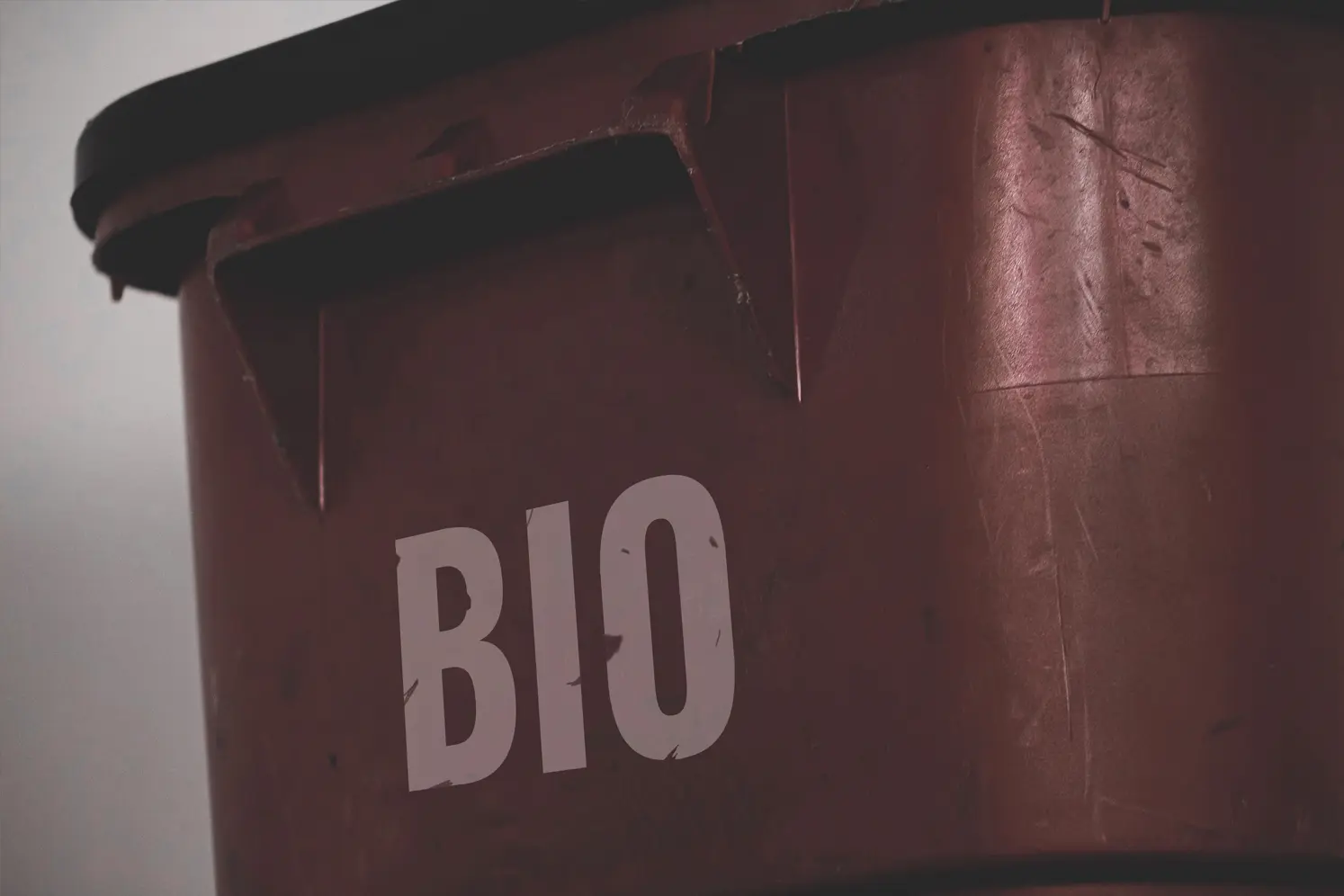BIO waste garbage cans - what do we throw in and in what? A compendium of what not to throw away with bio-waste

Segregation of waste has become an everyday occurrence today. Many doubts are still raised about the disposal of bio waste. What garbage can should they go into and what do we actually include in them? Learn all about it from this comprehensive guide.
Segregation of bio garbage. Why is it so important?
Segregation of bio-waste is one of the most important but often underestimated aspects of taking care of the environment. Bio-waste, or organic leftovers, make up a significant portion of our daily waste - segregating them properly is of paramount importance. Why?
- Bio-waste subjected to the composting process transforms into valuable compost, which is a natural and highly effective fertilizer that improves soil structure and increases soil fertility. This supports nature's natural processes while reducing the need for artificial chemical fertilizers, which can have a negative impact on the environment.
- Bio-waste that ends up in landfills decomposes under anaerobic conditions, leading to the emission of methane, a greenhouse gas that is dozens of times more harmful to the climate than carbon dioxide. By properly segregating and composting bio-waste, we significantly reduce the amount of methane released into the atmosphere, thus contributing to the fight against global warming.
- Proper segregation of bio-waste improves the efficiency of recycling systems. Less contaminated waste streams allow for better processing and recovery of raw materials, and this leads to savings in energy and natural resources.
- Segregation of bio-waste is also a matter of environmental education and building public awareness. Through daily practices, we learn to be responsible for our actions and their impact on the environment. This, in turn, can inspire further pro-environmental actions and changes for the better - not only in waste management, but also in other aspects of everyday life. By the way, we may also be more willing to bet on solutions that are smart and good for the planet, such as reaching for biodegradable straws instead of plastic ones.

Where does bio waste go?
Bio waste, after proper sorting, goes to special composting or biogas plants. In composting plants, they are processed under controlled conditions to produce high-quality compost used as a natural fertilizer in agriculture and horticulture. Bio-waste can also be diverted to biogas plants, where - through the process of anaerobic digestion - biogas is produced, which is a renewable energy source used to produce heat and electricity.
How to dispose of biodegradable waste? Basic information
Proper disposal of biodegradable waste is a key step in the process of turning it into valuable compost or biogas. In order to do this correctly, it is worthwhile to familiarize yourself with the basic rules for separating bio-waste. First of all, only materials that are organic and can decompose naturally should go into the biodegradable waste bin. This includes food scraps, fruit and vegetable peelings, coffee and tea grounds, vegetable waste from the garden, as well as eco-friendly disposable dishes or packaging labeledcompostable. Avoid throwing products containing plastic, metal, glass or other inorganic substances in there, as they can contaminate the composting process. Proper waste preparation, such as shredding, is also key - this speeds up the decomposition process and increases the efficiency of processing.

You can dispose of bio waste in compostable packaging. Use, for example, 200 pieces of paper bags with handles 26 x 17 x 30 cm.
Bio waste - what color container?
Bio waste should be thrown into containers marked with the color brown. It is worth making sure that you use the correct container to avoid confusion and unnecessary problems with waste segregation.
What to throw bio waste in? We suggest
Bio waste is best disposed of in special biodegradable bags intended for composting. They decompose along with the contents, making the whole process more ecological and efficient. You can also use paper bags, which are also environmentally friendly and can be composted. Avoid using plastic bags - they can contaminate the compost and hinder its production process.
How to store bio waste at home?
It's a good idea to adjust the way you store bio waste at home to prevent unpleasant odors and the growth of pests. It is best to use small containers with lids that can be emptied regularly. It is also a good idea to place the waste in a cool place, if possible. Emptying the container regularly and keeping it clean will help keep your kitchen hygienic and fresh.

Bio waste - what do we put in the biodegradable waste garbage can?
Proper segregation of biodegradable waste is key to successful composting and processing of bio-waste. What do we put in the bio? Only materials that can decompose naturally should go into the brown garbage can. Below is a detailed list of waste that can be thrown into this bin.
- Food leftovers: all peelings, skins and leftovers of vegetables and fruits, egg shells, coffee and tea grounds.
- Kitchen leftovers: old bread, cereal products, pasta, rice, breakfast cereals that are no longer suitable for consumption.
- Plant residues: wilted flowers, leaves, grass, branches, sawdust and tree bark.
- Biodegradable paper products: bags made of recycled paper, biodisposable packaging, labeled as compostable.
- Vegetable waste: nut shells, fruit stones, leftover herbs and potted plants.
- Biodegradable packaging: compostable bags, bio-plastic packaging and utensils, such as eco-friendly disposable cups labeled as biodegradable.
What don't we put in bio? This is worth remembering
Proper segregation of bio waste also requires awareness of what to absolutely not put in bio. Some materials, while they may appear organic, can disrupt the composting process and harm the environment. Here's a list of things to avoid when disposing of biodegradable waste.
- Plastic and other plastics: even those that appear biodegradable if they are not clearly labeled as compostable.
- Glass and metal: bottles, cans, aluminum foil, cutlery.
- Chemicals and cleaning products: detergents, pesticides, paints.
- Cooking fats and oils: large amounts of oil, fats, lard.
- Hygiene products: disposable diapers, tampons, sanitary pads, wet wipes.
- Medical waste: bandages, syringes, dressings.
- Ash and charcoal: leftovers from a fireplace or barbecue.
- Animal remains: bones, hides, fat.
- Paper products: towels, cards, cartons, newspapers, etc.
- Products with synthetic additives: synthetic fabrics, hair elastics, sponges.
Many people search the Internet for answers to questions related to what can and absolutely should not be disposed of in the biodegradable waste garbage can. We answer the most common questions.
Is bread for bio? Yes, but only dry, without additives.
Do we put bones in bio? No, animal scraps cannot be disposed of in bio waste.
Do we put seeds in bio? Yes.
Do we put citrus in bio? Yes.
Earth to bio waste - yes or no? No.
Do we put meat in bio? No, as is the case with bones.
Proper segregation of bio-waste is not only a matter of following the rules, but also of caring for the planet. Each of us has a real impact on the quality of our compost and on reducing the amount of waste going to landfills. By putting the right scraps in your bio waste garbage can, you are contributing to creating valuable resources for soil and agriculture! Environmental education and awareness are key to a more sustainable world. Let's work together to ensure that our bio-waste goes where it can do the most good, helping to protect the environment for future generations.
See other posts:
How to make an Easter basket from paper? Step-by-step instructions and our suggestions!
Eco-friendly shopping, or how to live healthy and with care for nature?
Folding napkins for a wedding - step by step. A way to make a practical decoration on the table!
Biodegradability - what is it, what sign it is marked with and what plastics are biodegradable?
Bio-waste - what is biodegradable garbage and what do we include in it?
